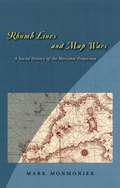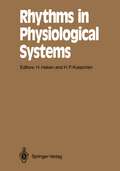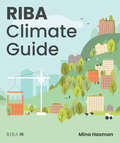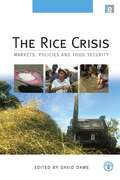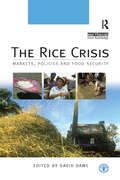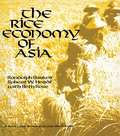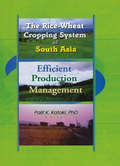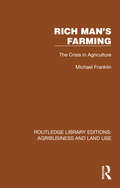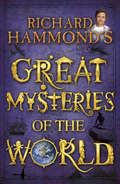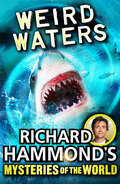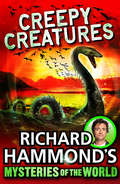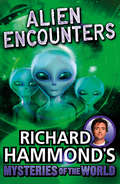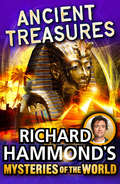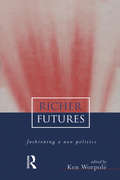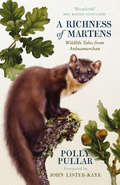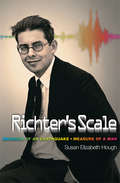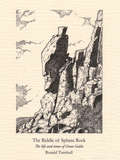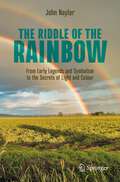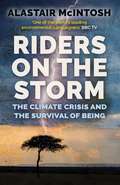- Table View
- List View
Rhumb Lines and Map Wars: A Social History of the Mercator Projection
by Mark MonmonierIn Rhumb Lines and Map Wars, Mark Monmonier offers an insightful, richly illustrated account of the controversies surrounding Flemish cartographer Gerard Mercator's legacy. He takes us back to 1569, when Mercator announced a clever method of portraying the earth on a flat surface, creating the first projection to take into account the earth's roundness. As Monmonier shows, mariners benefited most from Mercator's projection, which allowed for easy navigation of the high seas with rhumb lines—clear-cut routes with a constant compass bearing—for true direction. But the projection's popularity among nineteenth-century sailors led to its overuse—often in inappropriate, non-navigational ways—for wall maps, world atlases, and geopolitical propaganda. Because it distorts the proportionate size of countries, the Mercator map was criticized for inflating Europe and North America in a promotion of colonialism. In 1974, German historian Arno Peters proffered his own map, on which countries were ostensibly drawn in true proportion to one another. In the ensuing "map wars" of the 1970s and 1980s, these dueling projections vied for public support—with varying degrees of success. Widely acclaimed for his accessible, intelligent books on maps and mapping, Monmonier here examines the uses and limitations of one of cartography's most significant innovations. With informed skepticism, he offers insightful interpretations of why well-intentioned clerics and development advocates rallied around the Peters projection, which flagrantly distorted the shape of Third World nations; why journalists covering the controversy ignored alternative world maps and other key issues; and how a few postmodern writers defended the Peters worldview with a self-serving overstatement of the power of maps. Rhumb Lines and Map Wars is vintage Monmonier: historically rich, beautifully written, and fully engaged with the issues of our time.
Rhumb Lines and Map Wars: A Social History of the Mercator Projection
by Mark MonmonierIn Rhumb Lines and Map Wars, Mark Monmonier offers an insightful, richly illustrated account of the controversies surrounding Flemish cartographer Gerard Mercator's legacy. He takes us back to 1569, when Mercator announced a clever method of portraying the earth on a flat surface, creating the first projection to take into account the earth's roundness. As Monmonier shows, mariners benefited most from Mercator's projection, which allowed for easy navigation of the high seas with rhumb lines—clear-cut routes with a constant compass bearing—for true direction. But the projection's popularity among nineteenth-century sailors led to its overuse—often in inappropriate, non-navigational ways—for wall maps, world atlases, and geopolitical propaganda. Because it distorts the proportionate size of countries, the Mercator map was criticized for inflating Europe and North America in a promotion of colonialism. In 1974, German historian Arno Peters proffered his own map, on which countries were ostensibly drawn in true proportion to one another. In the ensuing "map wars" of the 1970s and 1980s, these dueling projections vied for public support—with varying degrees of success. Widely acclaimed for his accessible, intelligent books on maps and mapping, Monmonier here examines the uses and limitations of one of cartography's most significant innovations. With informed skepticism, he offers insightful interpretations of why well-intentioned clerics and development advocates rallied around the Peters projection, which flagrantly distorted the shape of Third World nations; why journalists covering the controversy ignored alternative world maps and other key issues; and how a few postmodern writers defended the Peters worldview with a self-serving overstatement of the power of maps. Rhumb Lines and Map Wars is vintage Monmonier: historically rich, beautifully written, and fully engaged with the issues of our time.
Rhythms in Physiological Systems: Proceedings of the International Symposium at Schloß Elmau, Bavaria, October 22–25, 1990 (Springer Series in Synergetics #55)
by Hermann Haken Hans P. KoepchenRhythms are a basic phenomenon in all physiological systems. They cover an enormous range of frequencies with periods from the order of milliseconds up to some years. They are described by many disciplines and are investigated usually in the context of the physiology of the respective function or organ. The importance given to the research on rhythmicity is quite different in different systems. In some cases where the functional significance is obvious rhythms are at the center of interest, as in the case of respiration or locomotion. In other fields they are considered more or less as interesting epiphenomena or at best as indicators without essential functional significance, as in the case of cardiovascular or EEG rhythms. Recently the study of physiological rhythms has attracted growing interest in several fields, especially with respect to rhythm research in humans and its rapidly spreading applications in basic behavioral research, and as a diagnostic tool in clinical medicine. This development was favored by two methodological and conceptual ad vances: on the one hand, the availability of non-invasive methods of continu ous recording of physiological parameters and their computer-assisted evaluation, and on the other, the rapid development of theoretical analyses, for example, the understanding of dynamic systems, the generation of coordinated macroscopic pro cesses in systems comprising many single elements, and the mathematical tools for treating nonlinear oscillators and their mutual coupling.
RIBA Climate Guide
by Mina HasmanClimate change is a threat to humankind, which requires immediate action. The built environment has a vital role to play in responding to the climate emergency. There is a pressing need for architects to acquire the requisite skills and knowledge to design buildings that deliver sustainable outcomes, meeting the RIBA 2030 Climate Challenge and mandatory competence in climate literacy. Equipping you with the key information that built environment professionals require to halt climate change and mitigate its impacts in your day-to-day work, this book is organised around six overarching topics: 1. Human Factors 2.Circular Economy 3.Energy and Carbon 4.Water 5.Ecology and Biodiversity 6.Connectivity and Transport Featuring images and original illustrations, each themed section will guide you through fundamental elements and competencies for creating a sustainable design and delivery framework that can be implemented by you in your practice. Contextualising the climate emergency within the built environment landscape, the guide maps out the essential background knowledge around climate science, international agreements, legislations, commitments and roadmaps. A collection of short, building- and urban-scale case studies present key takeaways, illustrating real-life applications of design strategies and industry-wide tools, as well as standards that are deployed in climate-conscious built environments all around the world.
RIBA Climate Guide
by Mina HasmanClimate change is a threat to humankind, which requires immediate action. The built environment has a vital role to play in responding to the climate emergency. There is a pressing need for architects to acquire the requisite skills and knowledge to design buildings that deliver sustainable outcomes, meeting the RIBA 2030 Climate Challenge and mandatory competence in climate literacy. Equipping you with the key information that built environment professionals require to halt climate change and mitigate its impacts in your day-to-day work, this book is organised around six overarching topics: 1. Human Factors 2.Circular Economy 3.Energy and Carbon 4.Water 5.Ecology and Biodiversity 6.Connectivity and Transport Featuring images and original illustrations, each themed section will guide you through fundamental elements and competencies for creating a sustainable design and delivery framework that can be implemented by you in your practice. Contextualising the climate emergency within the built environment landscape, the guide maps out the essential background knowledge around climate science, international agreements, legislations, commitments and roadmaps. A collection of short, building- and urban-scale case studies present key takeaways, illustrating real-life applications of design strategies and industry-wide tools, as well as standards that are deployed in climate-conscious built environments all around the world.
The Rice Crisis: Markets, Policies and Food Security
by David DaweThe recent escalation of world food prices – particularly for cereals - prompted mass public indignation and demonstrations in many countries, from the price of tortilla flour in Mexico to that of rice in the Philippines and pasta in Italy. The crisis has important implications for future government trade and food security policies, as countries re-evaluate their reliance on potentially more volatile world markets to augment domestic supplies of staple foods. This book examines how government policies caused and responded to soaring world prices in the particular case of rice, which is the world's most important source of calories for the poor. Comparable case studies of policy reactions in different countries, principally across Asia, but also including the USA, provide the understanding necessary to evaluate the impact of trade policy on the food security of poor farmers and consumers. They also provide important insights into the concerns of developing countries that are relevant for future international trade negotiations in key agricultural commodities. As a result, more appropriate policies can be put in place to ensure more stable food supplies in the future. Published with the Food and Agriculture (FAO) Organization of the United Nations
The Rice Crisis: Markets, Policies and Food Security
by David DaweThe recent escalation of world food prices – particularly for cereals - prompted mass public indignation and demonstrations in many countries, from the price of tortilla flour in Mexico to that of rice in the Philippines and pasta in Italy. The crisis has important implications for future government trade and food security policies, as countries re-evaluate their reliance on potentially more volatile world markets to augment domestic supplies of staple foods. This book examines how government policies caused and responded to soaring world prices in the particular case of rice, which is the world's most important source of calories for the poor. Comparable case studies of policy reactions in different countries, principally across Asia, but also including the USA, provide the understanding necessary to evaluate the impact of trade policy on the food security of poor farmers and consumers. They also provide important insights into the concerns of developing countries that are relevant for future international trade negotiations in key agricultural commodities. As a result, more appropriate policies can be put in place to ensure more stable food supplies in the future. Published with the Food and Agriculture (FAO) Organization of the United Nations
The Rice Economy of Asia
by Randolph Barker Robert W. Herdt Beth RoseTo millions of people in the world, rice is the center of existence, especially in Asia, where more than 90 percent of the world's rice is grown. This book is about the trends and changes that have occurred in the Asian rice economy since World War II, but particularly since the introduction of new varieties of rice and modern technology in the mid-1960s. Although there is now a vast amount of literature and statistical data on various aspects of the subject, no single comprehensive treatment has previously been prepared. The Rice Economy of Asia not only provides such a treatment but also presents a clear picture of some of the critical issues dealing with productivity and equity --- as a glance at the table of contents will show. In addition to 18 chapters, there are an extensive bibilography, 150 tables, and 50 charts. The volume, as a whole, should be interesting and useful to decisionmakers at national and international levels, to professionals, and to students of development.
The Rice Economy of Asia
by Randolph Barker Robert W. Herdt Beth RoseTo millions of people in the world, rice is the center of existence, especially in Asia, where more than 90 percent of the world's rice is grown. This book is about the trends and changes that have occurred in the Asian rice economy since World War II, but particularly since the introduction of new varieties of rice and modern technology in the mid-1960s. Although there is now a vast amount of literature and statistical data on various aspects of the subject, no single comprehensive treatment has previously been prepared. The Rice Economy of Asia not only provides such a treatment but also presents a clear picture of some of the critical issues dealing with productivity and equity --- as a glance at the table of contents will show. In addition to 18 chapters, there are an extensive bibilography, 150 tables, and 50 charts. The volume, as a whole, should be interesting and useful to decisionmakers at national and international levels, to professionals, and to students of development.
The Rice-Wheat Cropping System of South Asia: Efficient Production Management
by Palit Kataki Suresh Chandra BabuThe lives of more than a billion people depend on the answer!This valuable book surveys the problems of the rice-wheat cropping system practiced on the Indo-Gangetic Plain (IGP). Introduced at the time of the Green Revolution, it transformed agriculture and produced thirty years of bumper crops. The Rice-Wheat Cropping System of South Asia: Efficient Production Management offers scientific analysis of the aftereffects of this intense cropping. The Rice-Wheat Cropping System of South Asia: Efficient Production Management focuses on the questions of soil depletion, pest infestation, and soil alkalinity as elements of declining productivity. Along with clear charts, maps, and graphs, it provides practical suggestions for improving and maintaining the productivity of this irreplaceable farmland. The Rice-Wheat Cropping System of South Asia looks at the problems that have arisen for both the rice and wheat phases, including: depletion of micronutrients degradation of major nutrients from unbalanced fertilization practices infestations of nematodes increasing soil alkalinity as a result of irrigationIt also suggests solutions for maintaining productivity, including: integrated pest management sustainable agriculture micronutrient fertilizersThis informative book and its companion volume, The Rice-Wheat Cropping System of South Asia: Trends, Constraints, Productivity and Policy, are essential planning tools for agronomists, policymakers, and agroeconomists. It is also a useful reference for anyone interested in the problems of famine and intensive cropping not only in South Asia but in the world.
The Rice-Wheat Cropping System of South Asia: Efficient Production Management
by Palit Kataki Suresh Chandra BabuThe lives of more than a billion people depend on the answer!This valuable book surveys the problems of the rice-wheat cropping system practiced on the Indo-Gangetic Plain (IGP). Introduced at the time of the Green Revolution, it transformed agriculture and produced thirty years of bumper crops. The Rice-Wheat Cropping System of South Asia: Efficient Production Management offers scientific analysis of the aftereffects of this intense cropping. The Rice-Wheat Cropping System of South Asia: Efficient Production Management focuses on the questions of soil depletion, pest infestation, and soil alkalinity as elements of declining productivity. Along with clear charts, maps, and graphs, it provides practical suggestions for improving and maintaining the productivity of this irreplaceable farmland. The Rice-Wheat Cropping System of South Asia looks at the problems that have arisen for both the rice and wheat phases, including: depletion of micronutrients degradation of major nutrients from unbalanced fertilization practices infestations of nematodes increasing soil alkalinity as a result of irrigationIt also suggests solutions for maintaining productivity, including: integrated pest management sustainable agriculture micronutrient fertilizersThis informative book and its companion volume, The Rice-Wheat Cropping System of South Asia: Trends, Constraints, Productivity and Policy, are essential planning tools for agronomists, policymakers, and agroeconomists. It is also a useful reference for anyone interested in the problems of famine and intensive cropping not only in South Asia but in the world.
Rich Man's Farming: The Crisis in Agriculture (Routledge Library Editions: Agribusiness and Land Use #10)
by Michael FranklinOriginally published in 1988, this book was written at a time of excessive budgetary costs, huge surpluses and damaging trade conflicts. This study examines why a crisis situation was allowed to develop, nd proposes the most effective ways, both nationally and internationally – to chieve more rational agricultural support and trade policies. It concentrates on the efforts to reform the Common Agricultural Policy in the EU, on United States support policies, and on the GATT negotiations.
Rich Man's Farming: The Crisis in Agriculture (Routledge Library Editions: Agribusiness and Land Use #10)
by Michael FranklinOriginally published in 1988, this book was written at a time of excessive budgetary costs, huge surpluses and damaging trade conflicts. This study examines why a crisis situation was allowed to develop, nd proposes the most effective ways, both nationally and internationally – to chieve more rational agricultural support and trade policies. It concentrates on the efforts to reform the Common Agricultural Policy in the EU, on United States support policies, and on the GATT negotiations.
Richard Hammond's Great Mysteries of the World
by Richard HammondRichard Hammond - TV presenter and self-confessed mystery addict - invites you to journey with him to the planet's most puzzling places . . . Explore the ancient pyramids, Stonehenge and the Bermuda Triangle. Hunt for werewolves, vampires, aliens and the Abominable Snowman. You can gather clues, facts and interesting tales as you go (just try not to get too distracted by Richard's unbelievable jokes). Then it's up to you decide what's really going on.Don't miss this incredible, fully illustrated gift book from Britain's best-loved TV personality. Explore the world's greatest mysteries - all from the comfort of your armchair!
Richard Hammond's Mysteries of the World: Weird Waters
by Richard HammondRichard Hammond - TV presenter and self-confessed mystery addict - is on a quest to uncover the truth behind the rumours and whispers around events in the world's waters.Was the lost city of Atlantis real? Do mermaids exist outside stories? And where is everybody who was on the Marie Celeste? Don't miss this instalment in the incredible series by Britain's best-loved TV personality. Explore the world's greatest mysteries - all from the comfort of your armchair!
Richard Hammond's Mysteries of the World: Creepy Creatures
by Richard HammondRichard Hammond - TV presenter and self-confessed mystery addict - is on a quest to uncover the truth behind the rumours and whispers around some of the world's strangest - and creepiest - creatures. Is the Loch Ness Monster real? Are you in danger of running into a yeti? And do werewolves and vampires exist outside teenage romance? Don't miss this instalment in the incredible series by Britain's best-loved TV personality. Explore the world's greatest mysteries - all from the comfort of your armchair!
Richard Hammond's Mysteries of the World: Alien Encounters
by Richard HammondRichard Hammond - TV presenter and self-confessed mystery addict - is on a quest to uncover the truth behind the rumours and whispers around some of the world's strangest alien encounters.Have you ever spotted a UFO? Are you in danger of alien abduction? And what did happen at Roswell? Don't miss this instalment in the incredible series by Britain's best-loved TV personality. Explore the world's greatest mysteries - all from the comfort of your armchair!
Richard Hammond's Mysteries of the World: Ancient Treasures
by Richard HammondRichard Hammond - TV presenter and self-confessed mystery addict - is on a quest to uncover the truth behind the rumours and whispers around some of the world's strangest ancient mysteries.Don't miss this instalment in the incredible series by Britain's best-loved TV personality. Explore the world's greatest mysteries - all from the comfort of your armchair!
Richer Futures: Fashioning a new politics (Earthscan Library Collection: Environmental And Resource Economics Set Ser.)
by Ken WorpoleIn every area of life, traditional, centralized party politics has been failing and the seeds of a new form of political life are being sown. This is true in housing, health, education, consumption and transport, where public policy is attracting increasing criticism. In an age of social alienation and urban despondency Richer Futures is a timely response to the growing interest in community-based, self-help action. It introduces new forms of communication and decision-making and sets out a programme for a sustainable politics.Contributions from some of the best-known thinkers and writers on contemporary urban, cultural and social policy (and campaigns) in Britain today pay tribute to the ideas and industrious activities of the influential writer and commentator Colin Ward. This uplifting collection of essays looks forward to a new politics of self-management and environmentally aware and sustainable lifestyles.Ken Worpole has written a number of books on urban and cultural policy, and a series of influential reports for Comedia, Demos and the Department of the Environment.Originally published in 1999
Richer Futures: Fashioning a new politics
In every area of life, traditional, centralized party politics has been failing and the seeds of a new form of political life are being sown. This is true in housing, health, education, consumption and transport, where public policy is attracting increasing criticism. In an age of social alienation and urban despondency Richer Futures is a timely response to the growing interest in community-based, self-help action. It introduces new forms of communication and decision-making and sets out a programme for a sustainable politics.Contributions from some of the best-known thinkers and writers on contemporary urban, cultural and social policy (and campaigns) in Britain today pay tribute to the ideas and industrious activities of the influential writer and commentator Colin Ward. This uplifting collection of essays looks forward to a new politics of self-management and environmentally aware and sustainable lifestyles.Ken Worpole has written a number of books on urban and cultural policy, and a series of influential reports for Comedia, Demos and the Department of the Environment.Originally published in 1999
A Richness of Martens: Wildlife Tales from Ardnamurchan
by Polly PullarWhen Les and Chris Humphreys moved to Ardnamurchan 15 years ago, little did they realise they would be sharing their home with some of Britain’s most elusive and misunderstood mustelids. Amongst all the animals and birds that visit their garden, they have formed a special bond with numerous pine martens, and have studied them and a cast of other creatures at close range through direct observation and via sensor-operated cameras.Naturalist and photographer Polly Pullar has known the Humphreys and their pine martens for many years. In this book she tells the remarkable story of the couple and their animal friends, interpolating it with natural history, anecdote and her own experiences of the wildlife of the area. The result is a fascinating glimpse into the life of a much misunderstood animal and a passionate portrait of one of Scotland’s richest habitats – the oakwoods of Scotland’s Atlantic seaboard.
Richter's Scale: Measure of an Earthquake, Measure of a Man
by Susan Elizabeth HoughBy developing the scale that bears his name, Charles Richter not only invented the concept of magnitude as a measure of earthquake size, he turned himself into nothing less than a household word. He remains the only seismologist whose name anyone outside of narrow scientific circles would likely recognize. Yet few understand the Richter scale itself, and even fewer have ever understood the man. Drawing on the wealth of papers Richter left behind, as well as dozens of interviews with his family and colleagues, Susan Hough takes the reader deep into Richter's complex life story, setting it in the context of his family and interpersonal attachments, his academic career, and the history of seismology. Among his colleagues Richter was known as intensely private, passionately interested in earthquakes, and iconoclastic. He was an avid nudist, seismologists tell each other with a grin; he dabbled in poetry. He was a publicity hound, some suggest, and more famous than he deserved to be. But even his closest associates were unaware that he struggled to reconcile an intense and abiding need for artistic expression with his scientific interests, or that his apparently strained relationship with his wife was more unconventional but also stronger than they knew. Moreover, they never realized that his well-known foibles might even have been the consequence of a profound neurological disorder. In this biography, Susan Hough artfully interweaves the stories of Richter's life with the history of earthquake exploration and seismology. In doing so, she illuminates the world of earth science for the lay reader, much as Sylvia Nasar brought the world of mathematics alive in A Beautiful Mind.
The Riddle of Sphinx Rock: The life and times of Great Gable
by Ronald TurnbullGrand to look at, grand to look from, and grand to climb' - so Great Gable was described over a hundred years ago. Probably the Lake District's best loved hill, it receives twenty thousand ascents each year and has seen the birth of two separate sorts of hill sport. In The Riddle of Sphinx Rock, award-winning outdoor writer Ronald Turnbull asks why we find Great Gable so irresistibly attractive. His answer suggests that the greatness of Gable is far more than just a matter of getting to the top. As he walks, scrambles and climbs, he explores the subtleties of its terrain and its geology, history and myths. You'll meet characters and locations that are an integral part of its story: Wordsworth and his Wheel of Fells, Fanny Mercer and her bad alpenstock technique, the Wadd Holes and Pillar Rock, Moses Rigg and Geoffrey Winthrop Young. By turns intriguing and funny, erudite and provocative, The Riddle of Sphinx Rock was chosen by Trail magazine as one of six top titles in its How To Be Mountain Literate section: 'A boutique history of one the UK's most fascinating mountains, filled with memorable characters, classic routes and derring-do. Puts you in the historic thick of one of our most atmospheric and iconic mountains.'
The Riddle of the Rainbow: From Early Legends and Symbolism to the Secrets of Light and Colour (Copernicus Books)
by John NaylorRainbows have been a source of fascination since time immemorial. They have been the subject of myth and superstition, an inspiration to poets, a challenge to painters, the object of intense scientific interest and a touchstone for ideas about the nature of light and colour. Above all, the rainbow has been the embodiment of wonder from the earliest times to the present day.Beginning with the circumstances in which you are likely to see a rainbow and descriptions of its salient features, this book recounts and explains the myths and superstitions about rainbows, and describes how poets, painters and, above all, leading scientists in every age have sought to discover and understand the rainbow’s secrets.Readers with a love of nature and art and an interest in the history of science will enjoy this attractive and informative book.
Riders on the Storm: The Climate Crisis and the Survival of Being
by Alastair McIntoshIn this profound new book, Alastair McIntosh explores the science, psychology and spirituality of climate change. He summarises the up-to-date science and shows the damage caused both by climate-change denial as well as exaggeration. In outlining the technological and policy options to cut greenhouse gases, he argues that neither will be anywhere near sufficient unless we grasp the ‘twin drivers’ – namely, world population and excess consumption - in ways that deepen people’s dignity and freedom.This book’s enduring importance will lie in the uniqueness of the remedies proposed: our urgent need to reconnect with the earth, to build community, and own inner lives of depth psychology and even spirituality. This transforms climate change into a chance to discover deeper aspects of our humanity. The result is a scintillating guide to what it takes to make us riders on the storm.
